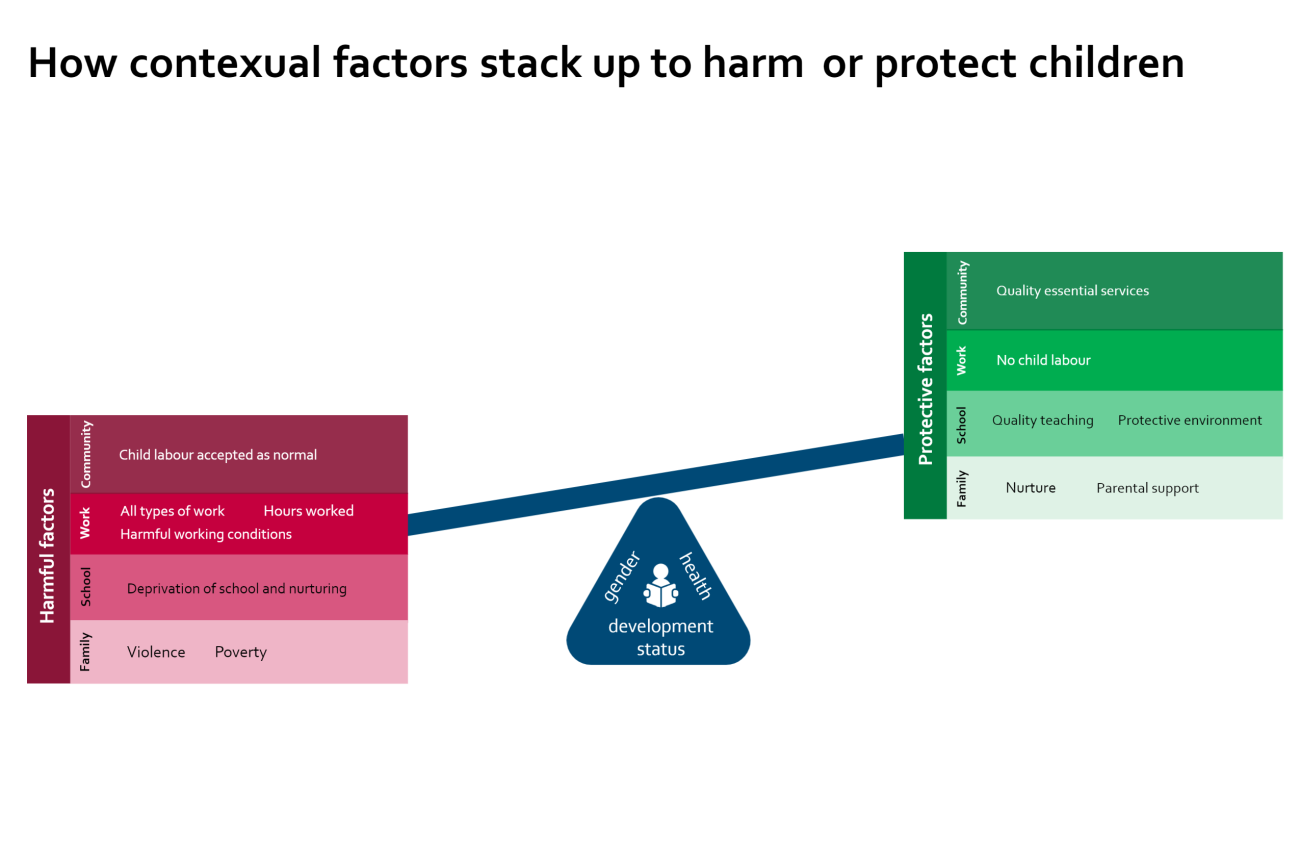According to a new review of child development research by ICI, understanding how and why child labour causes harm can help improve outcomes for children. The study provides practical suggestions to improve both how we identify children at risk, as well as what we do to prevent and address child labour and support children to reach their full potential.
The study (a review of over 150 empirical papers) illustrates clearly that child labour does not occur in a vacuum, but interacts with factors relating to the child, such as their age or general health status, and their environment, such as a nurturing family situation and quality schooling, leading to more or less harm to the child.
These findings have implications both for identifying the children that most need support and for designing the most effective and cost-efficient activities for preventing and remediating harm from child labour, as well as its occurrence.
Child labour and harm
Child labour can cause the same types of short-term and long-term harm as other adverse experiences in childhood, such as impaired brain development, poor physical and mental health, poor school achievement, and lower skills and socioeconomic status in adulthood. These negative impacts on future adults and parents also contribute to the perpetuation of child labour into future generations.
What affects how harmful child labour is?
The research illustrates several factors that can help protect children from harm linked to child labour, including for example, safe, stable and nurturing relationships from early childhood to adolescence. This means that access to quality education with supportive teachers can help mitigate the negative impacts of excessive work, or of a challenging family situation. On the other hand, the intensity of work (for example the number of hours worked) strongly determines how harmful child labour will be. When and how children are involved in child labour also plays a key role: the potential for harm is greater the younger a child is when they start working, the longer the hours worked, and when different types of work add up. In addition, individual characteristics of the child may determine how vulnerable the child is to harm. Girls, for example, are often more negatively impacted than boys, due to an accumulation of household chores and other types of work.

What does this mean for efforts to prevent and address child labour in the cocoa sector?
Identification of children at risk and measurement of progress
These findings suggest that collecting detailed information about a child’s situation and environment, can help assess how harmful child labour is likely to be, better identify appropriate support and better monitor impact over time.
For example, measuring the total time children spend on all types of work, including household chores (rather than only focusing on hazardous tasks), in addition to looking at the presence or absence of protective factors, can help better identify the children most at risk of harm, and prioritize them for support. Furthermore, assessing a wider range of outcomes such as child wellbeing, health and learning can help measure progress and highlight the positive impact of interventions on children.
ICI is currently exploring how to adapt its child labour identification tools to capture information about all types of work (not only hazardous tasks) and the age the child started working. More information on the efficacy of these approaches will be shared soon.
Prevention and remediation
The study provides further evidence of the importance of quality education to promote children’s healthy development, increase their resilience, and prevent and repair harm from child labour. While some ‘child labour’ interventions already prioritize out-of-school children for support regardless of whether the child engages in child labour, the evidence suggests this should be the norm.
The findings also suggest that early-years interventions with young children and parents could be particularly cost effective to build resilience and protect them from future harm. This could provide tangible benefits quickly. For children already involved in child labour, reducing the delay between when a child is identified and when they receive support is vital. This is because the longer the exposure the greater the likelihood of serious harm, requiring a more intense remedial response, beyond withdrawing the child from child labour.
Finally, the key role of children’s environment suggests that integrated strategies that include support to families (for example social protection, adult education and parenting skills), to schools (such as interventions to improve the quality of teaching and learning) and to the wider community (including provision of quality essential services, infrastructure and promotion of gender equality) are likely to be most effective at preventing harm from child labour, promoting healthy child development, and reducing child labour prevalence in the long run.
Want to put these findings into action? The following tools can help:
- ICI’s Child Labour Prevalence Survey includes questions to capture several elements of the severity of child labour, as well as health, wellbeing and learning outcomes.
- The Protective Community Index assessment tool measures the presence of quality services at community level that support children’s healthy development and are associated with lower rates of child labour. It can be used to identify gaps in provision, support intervention planning and monitor change over time.
- The Protective School Environment Assessmentis a simple tool to assess three dimensions of a quality learning environment: safety, stability, and nurturance. It can be used to monitor the impact of interventions to improve education quality.
